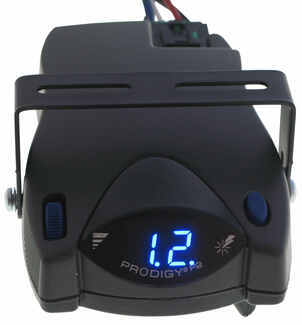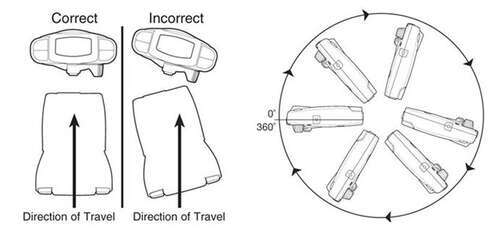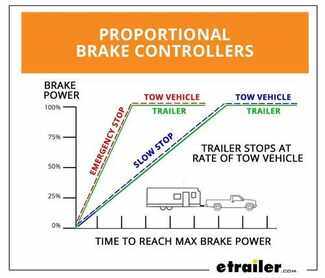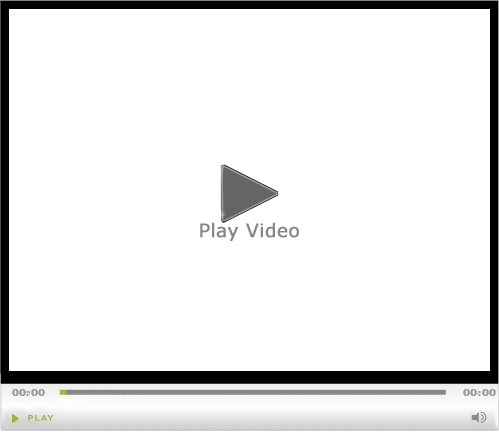


 Arrives before Christmas
Arrives before Christmas 

To see if this custom-fit item will work for you please tell us what vehicle you'll use it with.
This proportional brake controller keeps it simple with intuitive controls that are easy to use. Includes a large, digital LED display, 3 boost levels, battery protection, and continuous diagnostics.
Features:
Specs:
You can adjust the gain (also known as output) with the thumbwheel on the front of the controller. Gain lets you set the maximum amount of power that will be applied to your trailer's brakes. A heavier trailer will need more power to achieve smooth, safe braking, while a lighter trailer will need less. Typically, the gain is only readjusted when you experience changing road conditions or if the weight of your trailer changes.
The boost setting controls the aggressiveness of your trailer's braking, meaning how quickly the brakes reach the maximum braking level. You can adjust this when you're towing heavy loads and you need more umph to bring your trailer to a stop. Your tow vehicle doesn't need that much power to brake in time, but your heavy trailer does.
Depending on the level of boost, your trailer brakes can start at either 13 percent or 25 percent of the set gain. What this means is that, instead of starting at 0, the brakes will start at 25 percent and get to100 percent sooner. This keeps the trailer from pushing your tow vehicle forward.
If your trailer weighs less than your tow vehicle, no boost is needed. But, if you want your trailer to lead the braking, you can select level B1.
Boost Levels:
| Approximate Gross Trailer Weight | Boost Level | Increase in Initial Power Output |
|---|---|---|
| Less than tow vehicle GVW | B1 | 13% |
| Equal to tow vehicle GVW | B1 or B2 | 13% or 25% |
| Up to 25% more than tow vehicle GVW | B2 or B3* | 25% |
| Up to 40% more than tow vehicle GVW | B3* | 25% |
*Both B2 and B3 offer a 25-percent boost in initial power. But the braking curve for B3 is more aggressive than that of B2. This means that, even though you will start out with the same intensity when using these boost levels, you will get an overall more aggressive braking experience with the higher level. So if you use B3, you will reach maximum braking sooner than if you use B2.
Safety Features
The Prodigy P2 offers key safety features to prevent damage to various components of your towing setup. Integrated reverse battery protection shields the brake controller and your trailer's breakaway system from shorts. When the P2 is not in use, it will be in power-saving mode. In this setting, it draws only 3.6 milliamps, minimizing drain on your vehicle's battery.
The P2 also comes equipped with a hold feature to prevent wear on your brakes. When you're waiting at a red light, you don't need your trailer brakes on at full power. The longer you sit there, the more they will overheat. But with the P2, any time your tow vehicle and trailer are at a standstill with the brakes applied for more than 5 seconds, the hold feature will kick on and reduce power to just 25 percent. This will keep your trailer in place while saving your brakes.
The P2 keeps the manual override within easy reach, great for stopping sway or controlling your trailer's momentum in emergencies. To engage the manual override, just twist the rotary-style lever from right to left. This will activate the trailer's brakes and brake lights without you having to apply the brakes on your tow vehicle, perfect for limiting trailer movement while you're cruising.
The Prodigy P2 also offers diagnostics such as:
The self-leveling feature of the P2 ensures that the brake controller continues to function even as you drive up steep hills or through the mountains. Simply mount it in your cab at any vertical angle, and the controller will level itself automatically thanks to its 360-degree rotational range. This makes the installation that much easier. But keep in mind that the P2 must be horizontally level and parallel with the direction of travel to work correctly.
Installation is a snap. After mounting the P2 unit in your cab using the included bracket, just plug the custom harness directly into your vehicle. The other end plugs into the brake controller. To remove the P2 for storage when you're not using it, just unplug the unit and slide it out of the bracket. With a replacement wiring harness (sold separately) and replacement bracket (P7685 - sold separately), you can even transfer the Prodigy P2 to another vehicle.
Note: If you don't already have a 7-way plug at the back of your vehicle, take a look at our exclusive 7- and 4-way brake controller installation kit (ETBC7 - sold separately).
The Tekonsha Prodigy P2 brake controller comes equipped with proportional braking to give you the best towing experience. Proportional braking means that your trailer brakes mimic your tow vehicle's brakes. If you slam on the brakes in your vehicle, your trailer brakes will activate with the same intensity; if you brake lightly, your trailer brakes lightly too. The trailer's braking is in proportion to your vehicle's braking. This saves wear and tear on the tires and the brakes on both your vehicle and trailer.
The Prodigy P2 uses an internal inertia sensor to detect how your vehicle is braking so it can send the right amount of braking power to your trailer. It measures the inertia of your tow vehicle and activates the trailer's brakes to slow at the same rate. The result is uniform braking across your towing setup. No push-pull action - just smooth, proportional braking every time.
California residents: click here
Videos are provided as a guide only. Refer to manufacturer installation instructions and specs for complete information.
Today in our 2013 Dodge Durango, we're going take a look at and show you how to install the Tekonsha Prodigy P2 trailer brake controller. This is a proportional controller designed for use with one up to four axles. Part number on is 90885. We're also going to be using the Tekonsha plug-in wiring adapter, part number 3045-P. Now here you'll see the C on our screen. That's going to indicate that we've got a connection made to our trailer in the back.
We're going to have programmable boost levels. We'll have zero, one, two, and three. That's going determine how aggressively and how quickly our brakes are applied to our trailer. This is also going to be in addition to the already proportional system. The proportional aspect of the controller's a really nice feature. This is going to use a sensor inside of the controller to determine how quickly we're stopping.
If it's very fast and very immediate, it's going to ramp right up to maximum power very quickly. If it's one of the more stop and go or a more drawn out or a slower stop, something that we're just kind of creep into a stop, it's going to ramp up very slowly, going right up to our maximum power. Pull the lever over it, we'll be able to dial our maximum output to the rear of our trailer down, and also up. Now it's only going to go up .. It'll go right up to our 11 now.
As you can see, it'll go right up to max power using the rotary style lever here. This is your manual operation lever. You see, if we peg it over, it gets up there pretty quick. If we gradually bring it over, it's going to ramp it up slower. That's the same way the proportional system's going to work for us. Now setting our gain's important.
This really helps us to determine how much maximum braking force is going to go to the rear. As our trailer gets heavier, our gain should also increase. As it gets lighter, you just simply rotate our knob, and bring that right down. Now our P2 can be mounted in any orientation we like. We can have this all the way up vertical, up and down, as long as we stay on the vertical plane, it's going to offer 360 degrees of rotation. It offers us a continuous diagnostic check for proper connection and also a shorted magnet condition and a few other things. We've got reverse battery protection for both the vehicle and the break-away system. This can also be set up for electric over hydraulic brakes. The system also works proportionally in reverse, so it's great for backing into those tough, tight stops. As you can see, boost mode is going to be indicated by a small LED right here. Once we go down to no boost, that light's going to disappear. The boost modes are important. We've got zero, or boost off, then we've got one, two, and three. Now we'll set those based on the proportion of our trailer weight to our vehicle. If we've got a really heavy trailer, say something that weighs up to 40% more than our vehicle, we're going to want to be up in that high setting. That way, we'll get a nice quick, aggressive braking being sent to the rear. If the trailer weighs less than the vehicle that we're pulling it with, maybe we don't use any boost. Maybe we just go to the first level. Really nice to be able to adjust that to the weight of the trailer. Here you can see we've got a C. This is going to indicate that we've got a trailer connected situation. As soon as we we're to remove the plug from the rear of the vehicle, it's going to switch right over to NC. This is going to help us . and you can see it's flashing here. This is going to help us know if we happen to lose our connection as we are heading down the road with our trailer, which could really create a problem for us when we went to stop. Now installation is going to begin by removing this. It's kind of like a decorative or a cosmetic cover that's underneath the dash here. There's a couple of push pin fasteners that we'll take out. Then over here. All right. Then that should just come down out of the way for us. That'll allow us to access right up under the dash. Set that aside. If we want to, we can certainly re-install this. If not, we don't have to. Now here's our parking brake lever. It comes up to a little white panel here. Right above that, we're going to see our gray connector. That's what we'll plug into our pig tail. To release it, there's a little catch here on the bottom. We'll pull down on that and then just give it a push rearward and get it slid off. Once you have got that tab released, we'll just kind of push it forward slightly. There you see it's going to come right off there and be accessible. You can see that little tab. It's going to be located right there. You just want to pull down on that tab and then that'll allow you to slide it forward and out. Now we can take the end of the pig tail. It'll only slide in one way. Slide that in. You want to hear it click. Then we'll push and pull just to make sure that it's nice and secure. Now we're going to determine where to mount or bracket. We've got two choices. We've got the slide-in type here. The kit's also going to come with the type where we just put a small screw in the side. Now it's up to you. This one would be mounted kind of up here in this area, wherever you decided, or we can mount it kind of up in here. Same thing with the bracket. It can be mounted like this. It can go on the underside here, just like that, which I think that's where we're going to put ours, be somewhere in there just like that. We'll use the provided self-tapping screws. Put them right up in place there. As you can see, that gives us a nice secure mounting location without having to put any holes here in the front side of our dash, but of course if you decide that's where you want it, feel free. Drill a couple holes there and thread it right in. Now we can grab the brake controller itself. Also our pig tail. We'll slide it right under the back side. Make sure it clips. Give it a few good pulls. Then we can start positioning our controller where we want it. I like to keep them up as high as I can, be out of the way as much as possible. It looks like in this application, we'll be using the bottom holes. We're also going to have a couple of screws right here that we'll use for this bracket. We'll just tighten down our screws. That'll hold it in place. As you can see, that's tucked away nicely, right up against the bottom of our dashboard there. Now we'll just tuck our wire. There's a nice little cubby hole over here on the side where we can tuck most of our excess in. Then we'll use a zip tie, and we'll bring this right up here to the top. Now we don't want to go around the movable portion of it, but we've got a great opportunity to go right around our steering shaft up here. There's a fixed portion, or a portion that won't move when you turn the wheel. It's nice and high, so it's really going to draw our wire up there and get it out of the way for us. Of course trim off the excess on that. Tuck this on the way over here. It'll be great. Everything's up out of the way. We won't have to worry about any interference, and our controller is here, easily accessible, easy to operate. As you can see, the NC there. That's going to indicate no connection or no trailer connected. With everything working as it should, that's going to complete today's installation of the Tekonsha Prodigy P2 trailer brake controller, part number 90885. Also using the Tekonsha plug-in wiring adapter, part number 3045-P. All on our 2013 Dodge Durango. .

Do you have a question about this Trailer Brake Controller?
Info for this part was:
At etrailer.com we provide the best information available about the products we sell. We take the quality of our information seriously so that you can get the right part the first time. Let us know if anything is missing or if you have any questions.








Thank you! Your comment has been submitted successfully. You should be able to view your question/comment here within a few days.
Error submitting comment. Please try again momentarily.